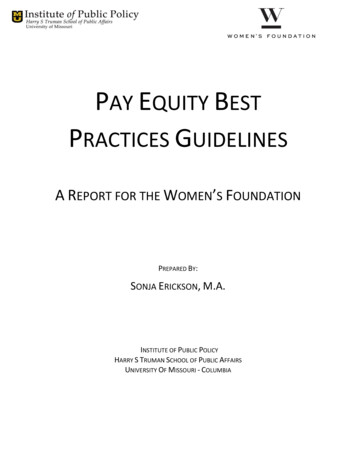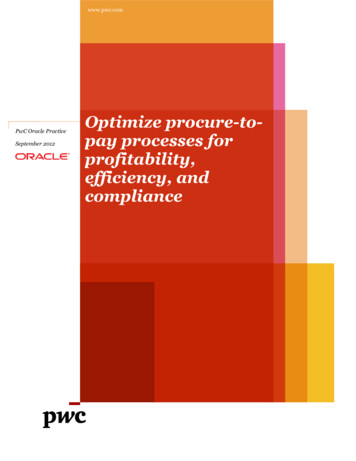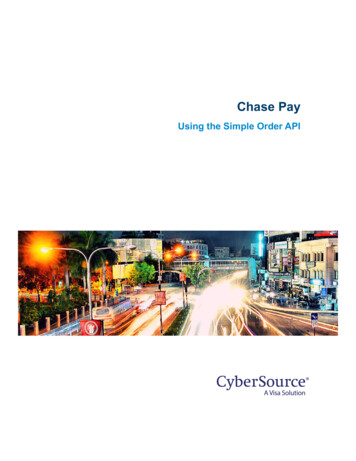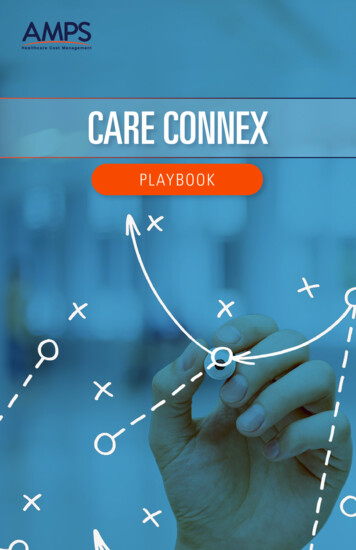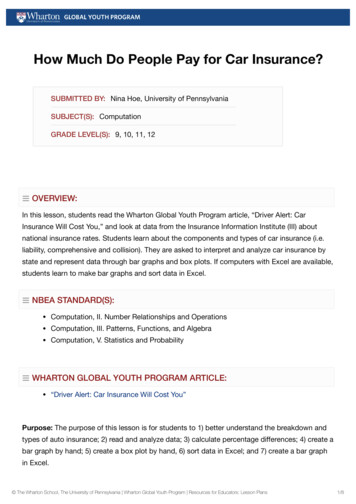
Transcription
How Much Do People Pay for Car Insurance?SUBMITTED BY: Nina Hoe, University of PennsylvaniaSUBJECT(S): ComputationGRADE LEVEL(S): 9, 10, 11, 12 OVERVIEW:In this lesson, students read the Wharton Global Youth Program article, “Driver Alert: CarInsurance Will Cost You,” and look at data from the Insurance Information Institute (III) aboutnational insurance rates. Students learn about the components and types of car insurance (i.e.liability, comprehensive and collision). They are asked to interpret and analyze car insurance bystate and represent data through bar graphs and box plots. If computers with Excel are available,students learn to make bar graphs and sort data in Excel. NBEA STANDARD(S):Computation, II. Number Relationships and OperationsComputation, III. Patterns, Functions, and AlgebraComputation, V. Statistics and Probability WHARTON GLOBAL YOUTH PROGRAM ARTICLE:“Driver Alert: Car Insurance Will Cost You”Purpose: The purpose of this lesson is for students to 1) better understand the breakdown andtypes of auto insurance; 2) read and analyze data; 3) calculate percentage differences; 4) create abar graph by hand; 5) create a box plot by hand, 6) sort data in Excel; and 7) create a bar graphin Excel. The Wharton School, The University of Pennsylvania Wharton Global Youth Program Resources for Educators: Lesson Plans1/8
Common Core Standards:S-ID.1. Represent data with plots on the real number line (dot plots, histograms, andbox plots).S-ID.2. Use statistics appropriate to the shape of the data distribution to comparecenter (median, mean) and spread (interquartile range, standard deviation) of two ormore different data sets.N-Q.1. Use units as a way to understand problems and to guide the solution of multistep problems; choose and interpret units consistently in formulas; choose and interpretthe scale and the origin in graphs and data displays.Resources/Materials:Computers with Microsoft ExcelWorksheetActivity:Class Discussion: (3 mins)1. What is insurance? What does having insurance mean?2. What is car insurance?3. Who needs to have it?Have students read the WGYP Article: “Driver Alert: Car Insurance Will Cost You” (5 – 10 mins,depending on if they have read article for Computation 5)4. Based on the article – is car insurance the same for everyone, everywhere?(No, all 50 states have different laws about the types of insurance that a driverneeds to carry and the amount of coverage required.)5. What is a premium?(A premium is the amount to be paid for an insurance policy.)(10 mins) The Wharton School, The University of Pennsylvania Wharton Global Youth Program Resources for Educators: Lesson Plans2/8
6. What are the different types of insurances and what do they mean?(All information from State Farm Website)These are three of the most common types of insurances.1. Liability – Auto liability insurance coverage pays for the damage if you are legallyresponsible for accidentally injuring someone, or for damaging another vehicle or otherproperty in an auto accident. Auto liability coverage falls into two categories: (1) BodilyInjury Liability – which covers medical expenses, pain and suffering, lost wages,and other special damages (2) Property Damage Liability — which coversdamaged property, and may include loss of use.Liability car insurance also pays legal defense and court costs. State laws usuallydictate the minimum amounts of auto liability insurance required, but higher amountsare available.2. Collision – This auto insurance coverage helps pay for damage to a covered vehiclecaused by:Collision with another vehicleCollision with an objectA vehicle rolloverA deductible is required.3. Comprehensive – This auto insurance coverage helps pay for loss of or damage to an insuredvehicle, not caused by a collision or vehicle rollover.Examples of this type of damage or loss include:FireWindHailFloodVandalismTheftHitting an animalA deductible may apply. The Wharton School, The University of Pennsylvania Wharton Global Youth Program Resources for Educators: Lesson Plans3/8
Discuss the meanings and applications of these types of insurance. Make sure that studentsunderstand what each is for. Talk about some different scenarios and which categories differenttypes of accidents would fall into (ex: a tree falling on your parked car – comprehensive, youhitting another car – liability and collision, you hitting a telephone pole but not causing anydamages – collision).7. Which types of insurances are most important and why?(These might depend on what type of car you have and how much it is worth. Forexample, if you have a very old car only worth a few hundred dollars, it might notbe worth it to pay for comprehensive or collision insurance since you might paymore in insurance than the car is worth. In all states, drivers are required to carryliability insurance at a minimum so that others are protected from any damage youmight cause.)Discuss that in Pennsylvania for example, the only type of insurance that is mandatory in liability.8. Is insurance the same for everyone everywhere?(No, we know that at least from the WGYP article)According to the Institute ofInsurance Information Institute:Expenditures are affected by the coverage purchased aswell as other factors. In states where the economy is healthy, people are more likelyto purchase new cars. Since new car owners are more likely to purchase physicaldamage coverage, these states will have a higher average expenditure. The NAICnotes that urban population, traffic density and per capita income have a significantimpact on premiums. The latest report shows that high premium states tend also to behighly urban, with higher wage and price levels and greater traffic density. Tort liabilityand other auto laws, labor costs, liability coverage requirements, theft rates andother factors can also affect auto insurance prices.2. Student Activity: (20 mins)Investigate the questions: How much do people pay for car insurance in the United States?The data below shows average annual expenditures for auto insurance by state in 2008 (from IIIwebsite). The Wharton School, The University of Pennsylvania Wharton Global Youth Program Resources for Educators: Lesson Plans4/8
Analyzing the data:1. Which 5 states have the overall highest average expenditures?(D.C., Louisiana, New Jersey, Florida, New York)2. Which 5 states have the overall lowest average expenditures?(North Dakota, Iowa, South Dakota, Nebraska, Idaho)3. What is the average expenditure for the United States as a whole?( 789)4. Between liability, collision, and comprehensive insurance, which tends to be thehighest? Why do you think this might be? The Wharton School, The University of Pennsylvania Wharton Global Youth Program Resources for Educators: Lesson Plans5/8
(Liability – it’s required)5. How does your state compare to the national average? Is it more or less? Calculate thepercentage different? Use this formula for percentage difference (let A the nationalaverage and B the average expenditure in your state).Express your answer in terms of “The annual average expenditure for auto insurance in(my state) is % higher/lower than the national average.”(The annual average expenditure for auto insurance in Pennsylvania is 3.5% higher thanthe national average.)6. In the WGYP article, according the Rocky Mountain Insurance Information, a policy for anewly licensed male teen driver will run about 1,000 every six months. How does thiscompare to the average expenditure for the state of Colorado in general? Specifically,what is the percentage difference?( 1000 x 2 2000. 2000 is 174% higher than 729, which is the state average.)7. In the space below, create a bar graph showing the average expenditures by state forthe 5 most expensive states and the 5 least expensive states. Within each category, listthem in order from most-to-least expensive.Before you start drawing What information should go on the x-axis? (states)What information should go on the y-axis? ( )7. Look at a map of the United States. Including your own state, select the 9 states closestto you (10 total). Make a box plot of average annual expenditures by those states. (Forexample, for PA, you might use NJ, DE, NY MD, OH, WV, DC, CT, and VA.)(if time allows – 10 mins) The Wharton School, The University of Pennsylvania Wharton Global Youth Program Resources for Educators: Lesson Plans6/8
9. Exploration in Excel.In the attached Excel file, you will find the data displayed in this file.Produce a bar (column) graph of the annual expenditure by state in alphabetical order.To do this: 1) Highlight the 2 columns (make sure to include the headings), 2) select the“Gallery” or “Graphs” button and chose “Column” 3) the graph should generateautomatically. 4) Cut and paste into a word document if desired.Produce a bar (column) graph of the annual expenditure by state in order of mostexpensive to least expensive. To do this you will need to first sort the data by theAverage Annual Expenditure ( ) or Column B. 1) Highlight all of the data, 2) under theData tab, select Sort, 3) Sort by Column B or Average Annual Expenditure ( ). Thenproduce a bar graph in the same way as in part 9a. To do this: 1) Highlight the 2columns (make sure to include the headings), 2) select the “Gallery” or “Graphs” buttonand chose “Column” 3) the graph should generate automatically. 4) Cut and paste into aword document if desired.Compare the two graphs. Which is more helpful/useful? Why?Using the graphs, approximate the mean. On which graph is it easier to locate orapproximate the mean?Tying It All Together: (10 mins)Have students reflect on all of the information that they have extracted from the raw data.Class Discussion:1. Have students report back on their answers.2. What are useful ways to display and organize data? Consider what you have done –lists, sorted lists, bar graphs, sorted bar graphs, box plots, calculations of percentagedifferences. Which one(s) were the most helpful? Discuss some of the pros and cons.3. Revisit the question – How much do people pay for car insurance? How did/could youanswer that question?1. What do the state averages represent?How do teen auto insurance rates fit into all of this? The Wharton School, The University of Pennsylvania Wharton Global Youth Program Resources for Educators: Lesson Plans7/8
The Wharton School, The University of Pennsylvania Wharton Global Youth Program Resources for Educators: Lesson Plans8/8
2. Collision - This auto insurance coverage helps pay for damage to a covered vehicle caused by: Collision with another vehicle Collision with an object A vehicle rolloverA deductible is required. 3. Comprehensive - This auto insurance coverage helps pay for loss of or damage to an insured vehicle, not caused by a collision or vehicle rollover.

